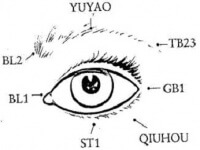Your eyes are two of the most complex organs in your body, but can often be taken for granted. Chinese medicine can help your eyes more than you know. It’s never too late to start taking better care of your eyes.
People with cataracts (which includes nearly all adults over the age of 65) are told there is nothing that can prevent the growth of cataracts and therefore to wait until the cataract “ripens” (gets more opaque) and then have it removed surgically, according to acufinder.com
This is a Western medicine approach, but in traditional Chinese medicine (TCM), so much more can be done than surgery. Eye diseases in TCM are closely related to a weakness in the liver and kidneys. If the liver and/or kidneys are weak, then vision will be affected. Also, spleen health can also be a cause of something like cataracts because the spleen transports nutrients to the body, particularly in an upward direction, so if the spleen is deficient, cataracts may be a negative side effect. Acupuncture is recommended for people with eye problems and points along the liver channel will most likely be treated.
Self-Acupressure Techniques for Better Vision
Anyone can do self-acupressure too! There are a number of acupuncture/acupressure points around the eyes (basically around the orbits of the eyes which are the bones that surround the eyeballs). The points shown above are some of the major local eye points (from acufinder.com).
 Jingming (UB-1) Urinary Bladder Channel, lies where the inner corner of the eye meets the nose. Bladder 1 and 2 are perhaps the best two points for eye problems of all kinds from early-stage cataracts or glaucoma to hysteria with vision loss.
Jingming (UB-1) Urinary Bladder Channel, lies where the inner corner of the eye meets the nose. Bladder 1 and 2 are perhaps the best two points for eye problems of all kinds from early-stage cataracts or glaucoma to hysteria with vision loss.- Zanzhu (UB-2) Urinary Bladder Channel, lies in the depressions at the inner ends of the eyebrows.
- Yuyao Midpoint of the eyebrow in the hollow. Good for eye problems related to worry, excessive study and mental strain.
- Sizhukong (SJ 23) Sanjiao or Triple Burner Channel, in the depression at the outside end of the eyebrow. This is a local point good for eye and facial problems.
- Tongziliao (GB 1) Gall Bladder Channel, lies in the cavities on the outside corners of the eye sockets. Good for eye problems including conjunctivitis, red sore eyes, photophobia, dry, itchy eyes, early-stage cataracts and blurred vision, as well as lateral headaches.
- Qiuhou Midway between St-1 and GB-1 along the orbit of the eyes.
- Chengqi (St 1) directly blow the pupil on the infraorbital ridge bone. This is a main point for all eye problems.
GENTLY massage each acupuncture point around the orbit of the eye, starting with B1-1 and massaging each point as you go up and outward. Each point should be massaged for approximately 5-10 seconds. You can do this massage as often as you like over the course of the day. Keep breathing as you massage. Deep breathing helps the cells of your eyes receive the oxygen they need for healing.
Are you interested in becoming a certified acupuncture professional?
Visit the links below to explore our specialized acupuncture programs at a campus near you:
Featured Posts:

